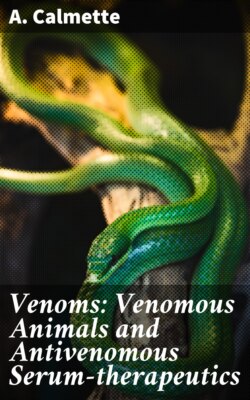Venoms: Venomous Animals and Antivenomous Serum-therapeutics

Реклама. ООО «ЛитРес», ИНН: 7719571260.
Оглавление
A. Calmette. Venoms: Venomous Animals and Antivenomous Serum-therapeutics
Venoms: Venomous Animals and Antivenomous Serum-therapeutics
Table of Contents
PART I. CHAPTER I. GENERAL NOTES ON POISONOUS ANIMALS—POISONOUS SNAKES: GENERAL CLASSIFICATION AND ANATOMO-PHYSIOLOGICAL CHARACTERS
I.—General Notes on Poisonous Animals
II.—General Classification of Poisonous Snakes. Their Anatomo-physiological Characters
CHAPTER II. HABITS OF POISONOUS SNAKES. THEIR CAPTURE
CHAPTER III. DESCRIPTION OF THE PRINCIPAL SPECIES OF POISONOUS SNAKES. THEIR GEOGRAPHICAL DISTRIBUTION
A.—EUROPE
Vipera ursinii
Vipera berus (Common Viper, or Adder)
Vipera aspis (Asp, or Red Viper) (Fig. 21, 2, and fig. 22.)
Vipera latastii
Vipera ammodytes (Fig. 21, 3 and 4)
B.—ASIA, DUTCH INDIES, AND PHILIPPINE ISLANDS
1. B. fasciatus (Banded Krait)
2. B. candidus
(b) Naja (Fig. 25.)
N. tripudians (Cobra-di-Capello). (Fig. 26.)
Naja samarensis
Naja bungarus (Ophiophagus or Hamadryas elaps) (King Cobra or Hamadryad.)
(c) Hemibungarus
(d) Callophis
(e) Doliophis
II.—Family Viperidæ
1.—VIPERINÆ (a) Vipera
(b) Pseudocerastes (Fig. 29.)
(c) Cerastes
(d) Echis
2.—CROTALINÆ (e) Ancistrodon
(f) Lachesis
C.—AFRICA
I.—Colubridæ
(a) Boulengerina
(b) Elapechis
(c) Naja (For the characters of this genus, see Asia, p. 33.)
(d) Sepedon
(e) Aspidelaps
(f) Walterinnesia
(g) Dendraspis (Fig. 34.)
II.—Viperidæ
(a) Causus (Fig. 35.)
(b) Vipera (For the characters of this genus, see p. 23—Europe.)
(c) Bitis (Fig. 36.)
(d) Cerastes
(e) Echis (See Asia, p. 48.)
(f) Atheris
(g) Atractaspis (Fig. 42.)
D.—AUSTRALIA AND THE LARGE ADJACENT ISLANDS
(a) Ogmodon
(b) Glyphodon
(c) Pseudelaps
(d) Diemenia
(e) Pseudechis
(f) Denisonia
(g) Micropechis
(h) Hoplocephalus
(i) Tropidechis
(j) Notechis
(k) Rhinhoplocephalus
(l) Brachyaspis
(m) Acanthophis (Death Adder) (Figs. 60, 61.)
(n) Elapognathus
(o) Rhynchelaps
(p) Furina (Figs. 63 and 64.)
E.—AMERICA
I.—COLUBRIDÆ (a) Elaps (Fig. 65.)
II.—VIPERIDÆ.—CROTALINÆ
(a) Ancistrodon
(b) Lachesis
(c) Sistrurus
(d) Crotalus (Rattle-Snakes)
F.—HYDROPHIINÆ (SEA-SNAKES)
(1) Hydrus (Fig. 77.)
(2) Thalassophis
(3) Acalyptophis
(4) Hydrelaps
(5) Hydrophis (Fig. 79.)
(6) Distira (Fig. 81.)
(7) Enhydris
(8) Enhydrina
(9) Aipysurus
(10) Platurus (Figs. 83, 84.)
G.—GEOGRAPHICAL DISTRIBUTION OF THE PRINCIPAL GENERA OF POISONOUS SNAKES IN THE FIVE DIVISIONS OF THE WORLD
PART II. CHAPTER IV. SECRETION AND COLLECTION OF VENOM IN SNAKES
Collection of Venom
CHAPTER V. THE CHEMICAL STUDY OF SNAKE-VENOMS
CHAPTER VI. THE PHYSIOLOGICAL ACTION OF SNAKE-VENOMS
A.—Physiology of Poisoning in Man and in Animals Bitten by the Different Species of Poisonous Snakes (Colubridæ; Viperidæ; Hydrophiidæ.)
B.—The Physiology of Experimental Poisoning
C.—Determination of the Lethal Doses of Venom for Different Species of Animals
D.—Effects of Venom in Non-Lethal Doses
CHAPTER VII. PHYSIOLOGY OF POISONING (continued)
Effects of the Various Venoms on the Different Tissues of the Organism
(1) Action upon the Liver
(2) Action upon the Kidney
(3) Action upon the Spleen, Heart, and Lungs
(4) Action upon the Striated Muscles
(5) Action upon the Nervous Centres
CHAPTER VIII. PHYSIOLOGY OF POISONING (continued)
Action of Venoms on the Blood
A.—Effects of Venom on the Coagulation of the Blood
I. Coagulant Venoms
II.—Anticoagulant Venoms
III.—Mechanism of the Anticoagulant Action of Venoms on the Blood
B.—Effects of Venom upon the Red Corpuscles
C.—Effects of Venom upon the White Corpuscles: Leucolysin
CHAPTER IX. PHYSIOLOGY OF POISONING (continued)
A.—Proteolytic Action
B.—Cytolytic Action
C.—Bacteriolytic Action
D.—Various Diastasic Actions of Venoms
E.—Action of Various Diastases upon Venoms
CHAPTER X. TOXICITY OF THE BLOOD OF VENOMOUS SNAKES
CHAPTER XI. NATURAL IMMUNITY OF CERTAIN ANIMALS WITH RESPECT TO SNAKE-VENOMS
CHAPTER XII. SNAKE-CHARMERS
PART III. ANTIVENOMOUS SERUM THERAPEUTICS. CHAPTER XIII. VACCINATION AGAINST SNAKE-VENOM—PREPARATION OF ANTIVENOMOUS SERUM—ITS PREVENTIVE PROPERTIES AS REGARDS INTOXICATION BY VENOM
CHAPTER XIV. NEUTRALISATION OF VENOM BY ANTITOXIN
CHAPTER XV. TREATMENT OF POISONOUS SNAKE-BITES IN MAN AND ANIMALS. OBJECTS OF THE TREATMENT: TECHNIQUE OF ANTIVENOMOUS SERUM-THERAPY
PART IV
CHAPTER XVI
1.—INVERTEBRATES
A.—Coelenterates
B.—Echinoderms
C.—Arthropods
(a) Araneida (Spiders)
(b) Scorpionidea (Scorpions)
(c) Myriopods
(d) Insects
D.—Molluscs
CHAPTER XVII. VENOMS IN THE ANIMAL SERIES (continued)
2.—VENOMOUS FISHES
A.—Teleostei.—Acanthopterygii
1.—Triglidæ
2.—Trachinidæ
3.—Gobiidæ
4.—Teuthididæ
5.—Batrachiidæ
6.—Pediculati
B.—Teleostei.—Plectognathi
C.—Teleostei.—Physostomi
1.—Siluridæ
2.—Murænidæ
CHAPTER XVIII. VENOMS IN THE ANIMAL SERIES (continued)
3.—BATRACHIANS.LIZARDS.MAMMALS
A.—Batrachians
B.—Lizards
C.—Mammals
PART V. DOCUMENTS. I.—A few Notes and Observations relating to Bites of Poisonous Snakes Treated by Antivenomous Serum Therapeutics
A.—Naja tripudians (India and Indo-China)
B.—Naja haje (Tropical Africa)
C.—Bungarus fasciatus
D.—Bungarus cæruleus
E.—Sepedon hæmachates (Berg-Adder)
F.—Hydrophiidæ (Sea-Snakes)
G.—European Vipers (Pelias berus and Vipera aspis)
H.—Echis carinata
I.—Cerastes
K.—Bitis arietans (Puff Adder)
L.—Lachesis ferox (known as the Grage, in French Guiana)
M.—Crotalus horridus
II.—A Few Notes and Observations Relating to Domestic Animals Bitten by Poisonous Snakes and Treated with Serum
A.—Naja haje
B.—Pelias berus (Common Viper)
C.—Cerastes
III.—Note on the Collection of Venom and the Treatment of Bites from Poisonous Snakes in the French Settlements in India. By Dr. Paul Gouzien. Principal Medical Officer of Colonial Troops
“Public Notice
INDEX
FOOTNOTES:
Отрывок из книги
A. Calmette
Published by Good Press, 2019
.....
(a) Vipera. (b) Pseudocerastes. (c) Cerastes. (d) Echis.
The Crotalinæ consist of only two genera:—
.....